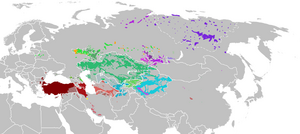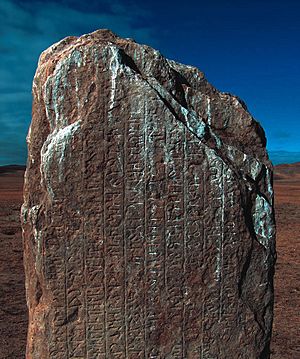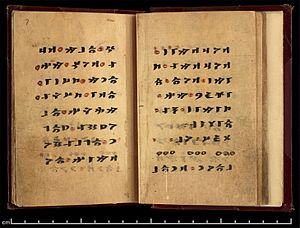Turkic languages facts for kids
Quick facts for kids Turkic |
|
|---|---|
| Ethnicity: | Turkic peoples |
| Geographic distribution: |
Central Asia East Asia North Asia Western Asia Eastern Europe Southern Europe |
| Linguistic classification: | One of the world's primary language families |
| Proto-language: | Proto-Turkic |
| Subdivisions: |
Shaz Turkic (Common Turkic)
Lir Turkic (Oghur)
|
| ISO 639-5: | trk |
 The distribution of the Turkic languages
|
|
The Turkic languages are a group of at least 35 languages. They are spoken by Turkic peoples across a huge area called Eurasia. This area stretches from Eastern Europe and Southern Europe all the way to Central Asia, East Asia, North Asia (like Siberia), and Western Asia.
These languages first appeared in East Asia, around Mongolia and Northwest China. This is where the very old language called Proto-Turkic is thought to have been spoken. From there, Turkic languages spread west during the first 1,000 years AD. They are like a "language chain," where nearby languages are easy to understand.
About 200 million people speak Turkic languages as their first language. If you include people who speak them as a second language, the total is over 230 million. The most widely spoken Turkic language is Turkish. It is mainly spoken in Anatolia (modern-day Turkey) and the Balkans. Turkish speakers make up about 38% of all Turkic speakers.
Turkic languages share many special features. These include vowel harmony, where vowels in a word must "match." They also use agglutination, which means adding many small parts to words to change their meaning. Sentences usually follow a subject-object-verb order. Also, these languages do not have grammatical gender (like "he" or "she" for objects).
Many Oghuz languages are easy for speakers to understand each other. These include Turkish, Azerbaijani, and Turkmen. Turkic languages are usually split into two main groups. One is Oghur, with Chuvash being its only living member. The other is Common Turkic, which includes all other Turkic languages.
Turkic languages are quite similar to Mongolic, Tungusic, Koreanic, and Japonic languages. Some experts thought they all came from one big family called Altaic. However, most experts today do not agree with this idea. Similarities with Uralic languages also led to the idea of a Ural-Altaic family. But there is not enough proof for these big families. The similarities are now thought to be from a lot of language contact long ago.
Contents
The History of Turkic Languages
Where Turkic Languages Began
Experts believe the homeland of the Turkic peoples and their language was in Northeastern Asia. This area is between the Transcaspian steppe and Manchuria. Other research points to South Siberia and Mongolia. This region is called the "Inner Asian Homeland" for Turkic people.
Some linguists, like Juha Janhunen, think modern-day Mongolia is where early Turkic languages started. Based on words about climate and animals, some experts place the first Turkic homeland near the Sayan-Altay region.
Around 1,000 BC, early Turkic people and early Mongol people had a lot of contact. They shared a culture called the "Turco-Mongol" tradition. They also shared a religion called Tengrism. Many words were borrowed between Turkic and Mongolic languages. Today, Turkic words make up most of the foreign words in Mongolian.
Similarities between Turkic and nearby Tungusic and Mongolic families are now seen as results of old contact. This is sometimes called the Northeast Asian sprachbund. More recent contact (around 1,000 BC) led to shared words. These words seem to have moved from Turkic to Mongolic, then from Mongolic to Tungusic.
Turkic languages also have some words borrowed from Chinese. This shows they had early contact with Chinese speakers.
Some researchers suggest the Turkic languages began in Manchuria. This area is close to where Mongolic, Tungusic, and Koreanic languages started. They believe these languages share a common "Transeurasian" origin.
First Written Records
The oldest known writings of Turkic languages are from the 8th century AD. These are the Orkhon inscriptions made by the Göktürks. They were found in 1889 in the Orkhon Valley in Mongolia. These writings show the Old Turkic language.
An important early book is the Compendium of the Turkic Dialects (Divânü Lügati't-Türk). It was written in the 11th century AD by Kaşgarlı Mahmud. This book is the first full dictionary of Turkic languages. It also has the first known map showing where Turkic speakers lived. It mostly focuses on the Southwestern branch of the family.
Another old language guide is the Codex Cumanicus (12th–13th centuries AD). It is about the Northwestern branch. This book helped Catholic missionaries learn the Kipchak language to speak with the Western Cumans. The earliest writings of the language spoken by Volga Bulgars (the ancestor of today's Chuvash language) are from the 13th–14th centuries AD.
How Turkic Languages Spread

During the Early Middle Ages (around 6th–11th centuries AD), Turkic peoples expanded their lands. Because of this, Turkic languages spread very quickly. In just a few centuries, they covered Central Asia, from Siberia to the Mediterranean.
Words from Turkic languages have been borrowed into many other languages. These include Persian, Hindustani, Ukrainian, Russian, Chinese, Mongolian, and Hungarian. Some Turkic words are also found in Arabic.
Today, Turkic-speaking people live across Eurasia. They are found from northeastern Siberia to Turkey in the west. (You can see a map in the box at the top of this page.)
For hundreds of years, Turkic-speaking people have moved around a lot. They have mixed with other groups. Their languages have also changed by being in contact with other languages. These include Iranian, Slavic, and Mongolic languages.
Because of this mixing, it can be hard to trace how each language group developed. Experts have created different ways to group the Turkic languages. Most modern ways of grouping them are based on the work of Samoilovich (1922).
The Turkic languages can be divided into six main groups:
- Common Turkic
- Southwestern (Oghuz Turkic)
- Southeastern (Karluk Turkic)
- Northwestern (Kipchak Turkic)
- Northeastern (Siberian Turkic)
- Arghu Turkic
- Oghur Turkic
In this grouping, Oghur Turkic is also called Lir-Turkic. The other groups are called Shaz-Turkic or Common Turkic. It is not clear when these two main types of Turkic languages first separated.
Some experts also group the Southwestern, Northwestern, Southeastern, and Oghur groups as West Turkic. The Northeastern, Kyrgyz-Kipchak, and Arghu (Khalaj) groups are sometimes called East Turkic.
Geographically, the Northwestern and Southeastern languages are considered central Turkic languages. The Northeastern and Khalaj languages are called peripheral languages.
Other Possible Connections
The Turkic language family is seen as one of the world's main language families. Turkic is also part of the Altaic language family, but this idea is still debated by experts. There are other theories about how Turkic languages might be related to others, but none are widely accepted.
Turkic Languages by Number of Speakers
- Further information: Lists of endangered languages, List of endangered languages in Russia, and List of endangered languages in China
Here is a list of Turkic languages, ordered by how many people speak them as their first language. The numbers are from 2019 and are rounded.
| Number | Name | Branch | Status | Native Speakers | Main Country | Main Writing System |
|---|---|---|---|---|---|---|
| 1 | Turkish language | Oghuz languages | Normal | 76,000,000 | Latin | |
| 2 | Uzbek language | Karluk languages | Normal | 35,000,000 | Latin | |
| 3 | Azerbaijani language | Oghuz languages | Normal | 30,000,000 | Latin | |
| 5 | Uyghur language | Karluk languages | Normal | 25,000,000 | Perso-Arabic | |
| 4 | Kazakh language | Kipchak languages | Normal | 19,000,000 | Latin | |
| 6 | Turkmen language | Oghuz languages | Normal | 7,000,000 | Latin | |
| 7 | Tatar language | Kipchak languages | Normal | 5,500,000 | Cyrillic | |
| 8 | Kyrgyz language | Kipchak languages | Normal | 5,000,000 | Cyrillic | |
| 9 | Bashkir language | Kipchak languages | Vulnerable | 1,500,000 | Cyrillic | |
| 10 | Chuvash language | Oghur languages | Vulnerable | 1,200,000 | Cyrillic | |
| 11 | Qashqai language | Oghuz languages | Normal | 1,000,000 | Perso-Arabic | |
| 12 | Khorasani Turkic language | Oghuz languages | Vulnerable | 1,000,000 | Perso-Arabic | |
| 13 | Karakalpak language | Kipchak languages | Normal | 650,000 | Latin | |
| 14 | Crimean Tatar language | Kipchak languages | Severely endangered | 600,000 | Latin | |
| 15 | Kumyk language | Kipchak languages | Vulnerable | 450,000 | Cyrillic | |
| 16 | Karachay-Balkar language | Kipchak languages | Vulnerable | 400,000 | Cyrillic | |
| 17 | Yakut language | Siberian Turkic languages | Vulnerable | 400,000 | Cyrillic | |
| 18 | Tuvan language | Siberian Turkic languages | Vulnerable | 300,000 | Cyrillic | |
| 19 | Urum language | Oghuz languages | Definitely endangered | 200,000 | Cyrillic | |
| 20 | Gagauz language | Oghuz languages | Critically endangered | 150,000 | Latin | |
| 21 | Siberian Tatar language | Kipchak languages | Definitely endangered | 100,000 | Cyrillic | |
| 22 | Nogai language | Kipchak languages | Definitely endangered | 100,000 | Cyrillic | |
| 23 | Salar language | Oghuz languages | Vulnerable | 70,000 | Latin | |
| 24 | Altai language | Siberian Turkic languages | Severely endangered | 60,000 | Cyrillic | |
| 25 | Khakas language | Siberian Turkic languages | Definitely endangered | 50,000 | Cyrillic | |
| 26 | Khalaj language | Arghu Turkic language | Vulnerable | 20,000 | Perso-Arabic | |
| 27 | Äynu language | Karluk languages | Critically endangered | 6,000 | Perso-Arabic | |
| 28 | Western Yugur language | Siberian Turkic languages | Severely endangered | 5,000 | Latin | |
| 29 | Shor language | Siberian Turkic languages | Severely endangered | 3,000 | Cyrillic | |
| 30 | Dolgan language | Siberian Turkic languages | Definitely endangered | 1,000 | Cyrillic | |
| 31 | Krymchak language | Kipchak languages | Critically endangered | 200 | Hebrew | |
| 32 | Ili Turki language | Karluk languages | Severely endangered | 100 | Cyrillic | |
| 33 | Tofa language | Siberian Turkic languages | Critically endangered | 100 | Cyrillic | |
| 34 | Karaim language | Kipchak languages | Critically endangered | 100 | Cyrillic | |
| 35 | Chulym language | Siberian Turkic languages | Critically endangered | 50 | Cyrillic | |
| Total | Turkic languages | Common Turkic languages | Normal | 179,000,000 | Latin |
Images for kids
See also
 In Spanish: Lenguas túrquicas para niños
In Spanish: Lenguas túrquicas para niños



